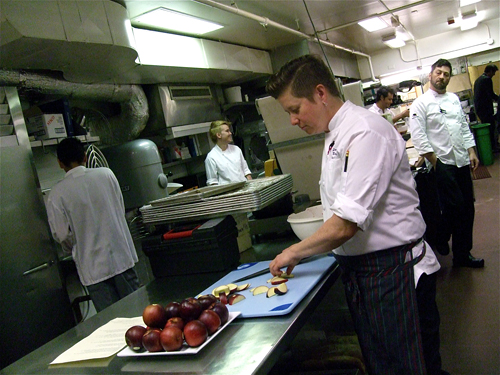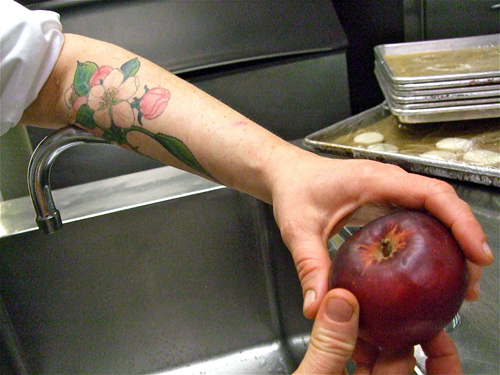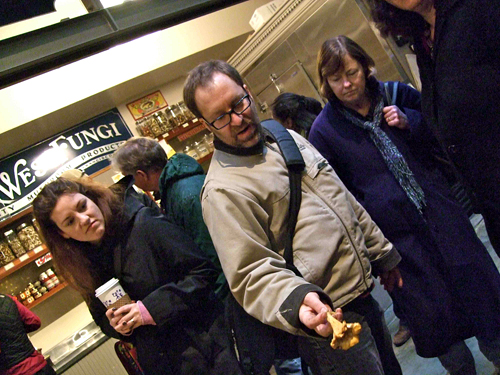
Eric Tucker holding a Chanterelle mushroom. Photo by Tamara Palmer
Chef Eric Tucker of Millennium Restaurant, a venerable temple to creative vegetarian cooking in San Francisco, was kind enough to let us tag along with him on a Saturday morning visit to the Ferry Plaza Farmers Market, where he was leading a small group who had signed up for a beer-themed cooking class in honor of the conclusion of SF Beer Week. No matter the theme of a particular course, Tucker will meet students the day before to wander the market and decide on some ideas and direction for the next day’s session, a hands-on class that includes sitting down to a family-style meal.
He first led the class to Far West Fungi, which has a permanent stall inside the building. Tucker snapped up some beautiful black trumpets, chanterelles, and maitakes. Mushrooms are a staple at Millennium for their earthy, meaty qualities, whether it’s a sauce of black trumpets in a red wine reduction or oyster mushrooms simply fried. Tucker’s advice for selecting shrooms focuses on what you should avoid, which is just as valuable to know as what to pick.
“I’m leery of mushrooms that look too waterlogged or dark. Those you have to dry or use very quickly,” he said. “If you’re buying portabellas and the gills are really present and the caps are really open, you need to use those quicker than ones with tighter caps, which will have more life.”
“Or look at these,” he noted, pointing to some mostly beige Lion’s Mane mushrooms. “When they start to turn red, I associate that with some possible bacterial growth or breakdown.”
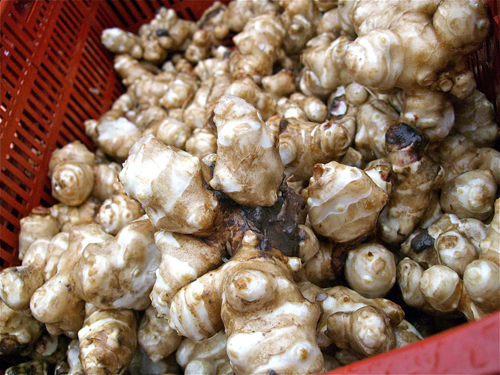
Sunchokes. Photo by Tamara Palmer
We ducked outside in the pouring rain to the Tierra Vegetables stand. Tucker started rifling through what we first thought were oversized knots of ginger root, but were actually sunchokes.
“You want the ones that are not caked in dirt, because they’re hard to clean and peel,” he explained, “And you want the larger ones.” While many like to work with raw sunchokes (shaving them thinly for a salad, for example), Tucker likes to slow bake them with white wine, olive oil, and herbs, the combination making a sort of guilt-free confit.
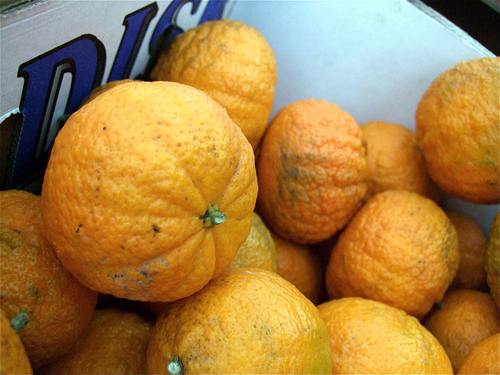
Golden Nuggets. Photo by Tamara Palmer
We finished at the Blossom Bluff Orchards stand, where some weird, nubbly looking mandarin oranges were about to be the subject of Tucker’s excitement.
“These are great for the zest!” he exclaimed of the variety, called Golden Nuggets. He likes to use them in savory applications, and for his beer class imagined they’d pair well with the bitterness of the hops in the different beer varieties. These can be a little difficult to pick. If they’re nubbier and heavier, they’ve got more juice, but they’ve also got thicker and more developed cell walls, so there’s a bit of a tradeoff when it comes to the insides.
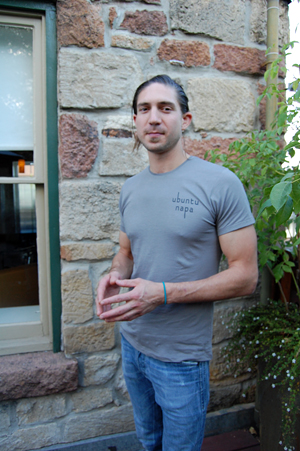
Aaron London. Photo courtesy of Ubuntu
It’s still a good time of year for carrots, and chef Aaron London of Napa’s notable vegetarian restaurant Ubuntu has some valuable advice and a colorful, flavorful recipe to share. No matter what color or size your carrots are, he notes that the pigmentation should be deep and plush. Look for strong, rigid stems and leaves with some sheen to them that blossom out and don’t lay flat.
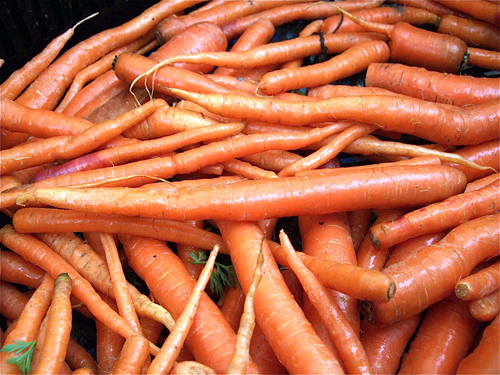
Carrots. Photo by Tamara Palmer
“If you’re at a Farmers' Market,” London says, “dirt is a good thing to see on a carrot. If it has dirt on it and any moisture, it will degrade and diminish very rapidly, meaning that if you see a soil covered carrot with all of the above attributes, then you’re really looking good because it must be super fresh. I know this sounds redundant, but it should smell like a carrot. Take that in mind and try hard to find a carrot that actually smells like one, and you will have found a winner.”
Tender White Satin and Crisp Purple Haze Carrot Salad With Strawberry Spinach, Raspberries, and Crushed Herb Vinaigrette
By Chef Aaron London, Ubuntu Restaurant
Serves: 6
Ingredients:
2 large carrots, peeled and sliced thin
Peel of 1/4 of an orange
1/4 onion, sliced thinly
2 oranges
1 Tbs. sugar
Mixed color baby carrots, carrot tops reserved for cooking and for garnish
1/2 pint raspberries
1 qt. picked greens, such as arugula, chervil, celery leaf, and mint
1 cup grapeseed oil
2 Tbs. crushed toasted hazelnuts
1 big handful of baby spinach
3 cloves crushed garlic
1 sprig rosemary
Salt
1Tbs. sugar
Edible flowers, or garnish of choice
For the carrot puree:
Sweat the onion, sliced large carrot, and orange peel in a little grapeseed oil with salt in a heavy bottomed pot until very tender. Add 1 pint of water and reduce it by half.
Place the carrots into a blender and blend on high until smooth and the mixture blends easily. At the end, drizzle in a thin stream of 1tsp. of oil to emulsify it and make it creamy and fluffy. Reserve puree.
For the tender carrots:
Wash the carrots and tops very well. Clean the tops off of all the baby carrots, and reserve some of the smaller leaves on the herb in ice water for garnish. Place the rest of the tops in the bottom of a roasting pan.
Lay 2/3 of the carrots on the carrot tops in 1-2 even layers, followed by the garlic, whole sprig rosemary, peel and juice of 1 orange, the sugar, enough water to cover and a pinch of salt. Cover with tin foil and cook until tender, about an hour, at 350. Once they are done, let them rest in their liquid until it is time to plate.
For the crisp carrots:
Take the remaining carrots and cut them into interesting shapes as well as shave on a mandolin. Place the carrots them directly into ice water so they crisp up and tork (twist into natural shapes).
For the vinaigrette:
Place the grapeseed oil in the freezer for 30 minutes before you need to use it. Blanch and shock the quart of “rabbit greens” (greens of choice as listed above) and place them in the blender with the oil and spin until smooth. Chill immediately.
Place the raspberries into a mixing bowl and lightly fork crush them with the micro-planed zest of 1 orange, a pinch of salt and a twist of pepper. Add in the hazelnuts and ½ cup of the green oil and let marinate for half an hour.
To finish:
Spread the carrot puree nice and wide on the bottom of 6 plates or wide bowls. The puree should be just above room temperature. Pull the tender carrots out of their cooking liquid and toss them in a bowl with the juice of one orange and a spoonful of the green oil and place them artfully into the puree.
Drain all of the water off of the raw carrots and toss them in a bowl with some of the green oil and a pinch of salt and dance them though the tender carrots, building as much height as possible.
